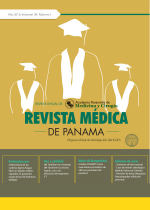Características clínicas e histopatológicas y evolución del Síndrome Nefrótico idiopático en niños atendidos en el Hospital de Especialidades Pediátricas. Años 2005 a 2010
Autores/as
DOI:
https://doi.org/10.37980/im.journal.rmdp.2014168Resumen
Resumen
Introducción: El síndrome nefrótico es un conjunto de enfermedades glomerulares que puede ser primaria o secundaria a una enfermedad sistémica. En Panamá no existen registros completos que describan las características clínicas del síndrome nefrótico primario, por lo que se plantea el describir las características clínicas del Síndrome Nefrótico primario, y su correlación con los hallazgos histopatológicos en niños atendidos en el Hospital de especialidades Pediátricas de la Caja de Seguro Social (HEPOTH), durante los años 2005 A 2010. Material y método: Se revisaron los expedientes clínicos de todos los niños egresados del HEPOTH y seguidos en la consulta externa del hospital con diagnóstico de Síndrome nefrótico primario, durante el periodo de enero de 2005 a diciembre de 2010. Resultados: Encontramos 43 pacientes con diagnóstico de Síndrome Nefrótico Primario atendidos en el HEPOTH entre los año 2005-2010, de los cuales se descartaron 9 pacientes por no contar con la información completa en el expediente clínico. El rango de edad de mayor predominancia fue 1-5 años y con una proporción masculino-femenino de 0.7 a 1.Todos presentaron edema y proteinuria, hipercolesterolemia, hipertrigliceridemia e hipoalbuminemia. El 79% de los pacientes resultó Cortico sensible y 21% cortico resistentes. De los pacientes cortico sensibles el 58 % presentó recaídas poco frecuentes, 45 % recaídas frecuentes y el 21 % cortico dependencia .Se realizó biopsia renal en 10 pacientes, los hallazgos histopatológicos mostraron Enfermedad de Cambios Mínimos (ECM) en un 50%,Glomerulonefritis membranosa en 20%, Membranoproliferativa, Esclerosis focal y segmentaria y Alport en 10% cada una. Conclusión: 1. Las características clínicas y epidemiológicas presentadas en los pacientes coincide con lo reportado en la literatura. 2. El hallazgo histopatológico más frecuente, fue la ECM. 3. En cuanto al tratamiento predominó el grupo de pacientes cortico sensibles.
Clinical and histopathologic features and evolution of idiopathic nephrotic syndrome in children treated at the Hospital of Pediatrics. Years 2005-2010.
Abstract
Introduction: The nephritic syndrome is a group of glomerular diseases that can be primary or secondary to a systemic disease. In Panama there are no complete records that describe the clinical characteristics of primary nephrotic syndrome, which arises to describe the clinical characteristics of primary nephrotic syndrome and its correlation with histopathologic findings in children treated at the Pediatric Hospital specialties Box Social Security (HEPOTH) during the years 2005 to 2010. Methods: The clinical records of all graduates HEPOTH children were reviewed and followed up in the outpatient clinic of the hospital with a diagnosis of primary nephrotic syndrome during the period January 2005 to December 2010. Results: We found 43 patients diagnosed with Primary Nephrotic Syndrome treated at the HEPOTH between 2005-2010 year, of which 9 patients were discarded due to lack of complete information in the clinical record. The age range of 1-5 years was greater predominance with a male-female ratio of 0.7 to 1.All presented edema and proteinuria, hypercholesterolemia, hypertriglyceridemia and hypoalbuminemia. 79% of the patients was 21% sensitive Cortico and cortico-resistant. Cortico-sensitive patients 58% had infrequent relapses, 45% frequent relapses and 21% .The dependence cortico renal biopsy performed in 10 patients, pathological findings showed Minimal Change Disease by 50%, membranous glomerulonephritis in 20% , Membranoproliferative, focal segmental sclerosis and Alport at 10% each. Conclusion: 1. the clinical and epidemiological characteristics presented in patients coincides with that reported in the literature. 2. the most common histopathological finding was the Minimal Change Disease. 3. Regarding the treatment group predominated cortico-sensitive patients.
Key Word: Nephritic syndrome, response to steroids, renal biopsy.
Publicado
Número
Sección
Licencia
Derechos autoriales y de reproducibilidad. La Revista Médica de Panama es un ente académico, sin fines de lucro, que forma parte de la Academia Panameña de Medicina y Cirugía. Sus publicaciones son de tipo acceso gratuito de su contenido para uso individual y académico, sin restricción. Los derechos autoriales de cada artículo son retenidos por sus autores. Al Publicar en la Revista, el autor otorga Licencia permanente, exclusiva, e irrevocable a la Sociedad para la edición del manuscrito, y otorga a la empresa editorial, Infomedic International Licencia de uso de distribución, indexación y comercial exclusiva, permanente e irrevocable de su contenido y para la generación de productos y servicios derivados del mismo. En caso que el autor obtenga la licencia CC BY, el artículo y sus derivados son de libre acceso y distribución.






